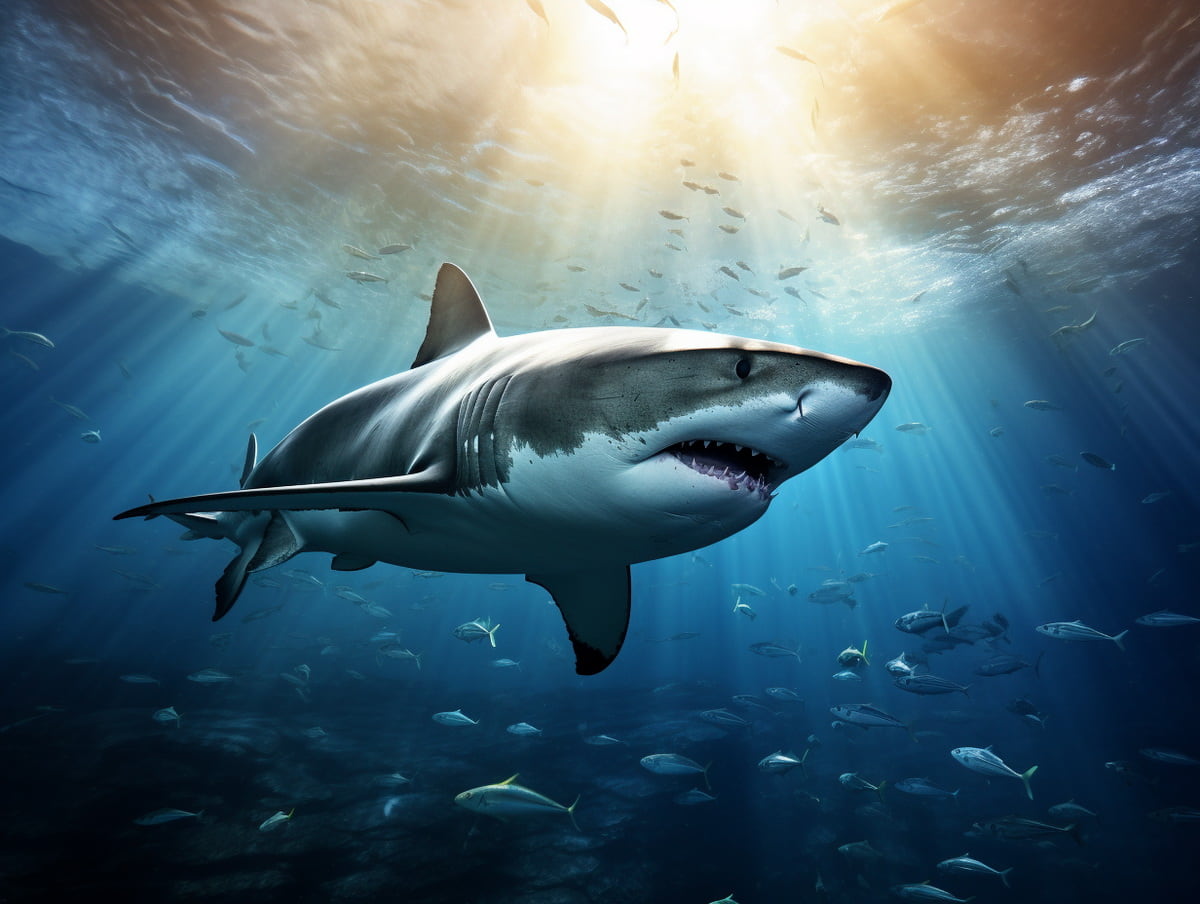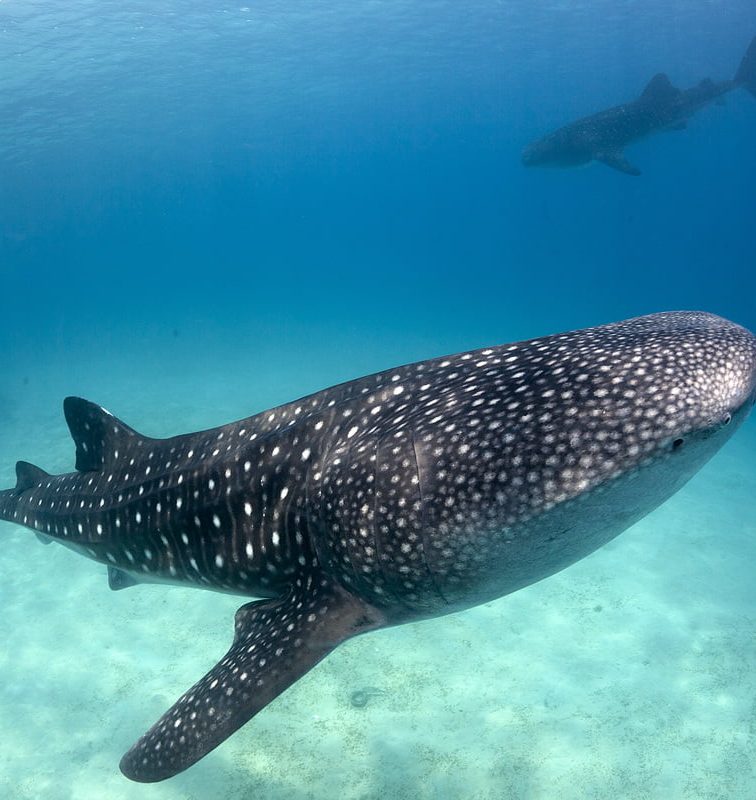Ever wondered about the sassiest swimmers of the seven seas? Well, dive right into our treasure trove of fun facts about sharks and discover the quirky, cool, and sometimes downright hilarious side of these finned wonders. From the fashion-forward zebra sharks to the ever-so-elegant angel sharks, there’s so much more to these creatures than just jaws and tales of the deep.
Whether you’re prepping for a trivia night or just in the mood for some fin-tastic shark fun facts for kids and adults alike, we’ve got you covered. And here’s a bonus: by the end of this article, you’ll not only be armed with the best shark-based icebreakers but also gain a newfound admiration for these oceanic marvels. Ready to make a splash with knowledge? Dive in!
1. The Tooth Fairy’s Favorite: Shark Teeth!
Sharks sure know how to keep the Tooth Fairy busy. Not only do these underwater celebrities lose teeth every week, but over their lifetime, they can sport up to 30,000 teeth. That’s like having a conveyor belt of pearly whites! If tooth fairies existed underwater, sharks would be swimming in riches.
With their multi-layered dental lineup, every time they lose one, a backup pops right into place. It’s the ultimate tooth replacement service. For kids especially, this fun tidbit makes the idea of losing a tooth seem a lot less scary. Who wouldn’t want a dental plan as efficient as a shark’s?
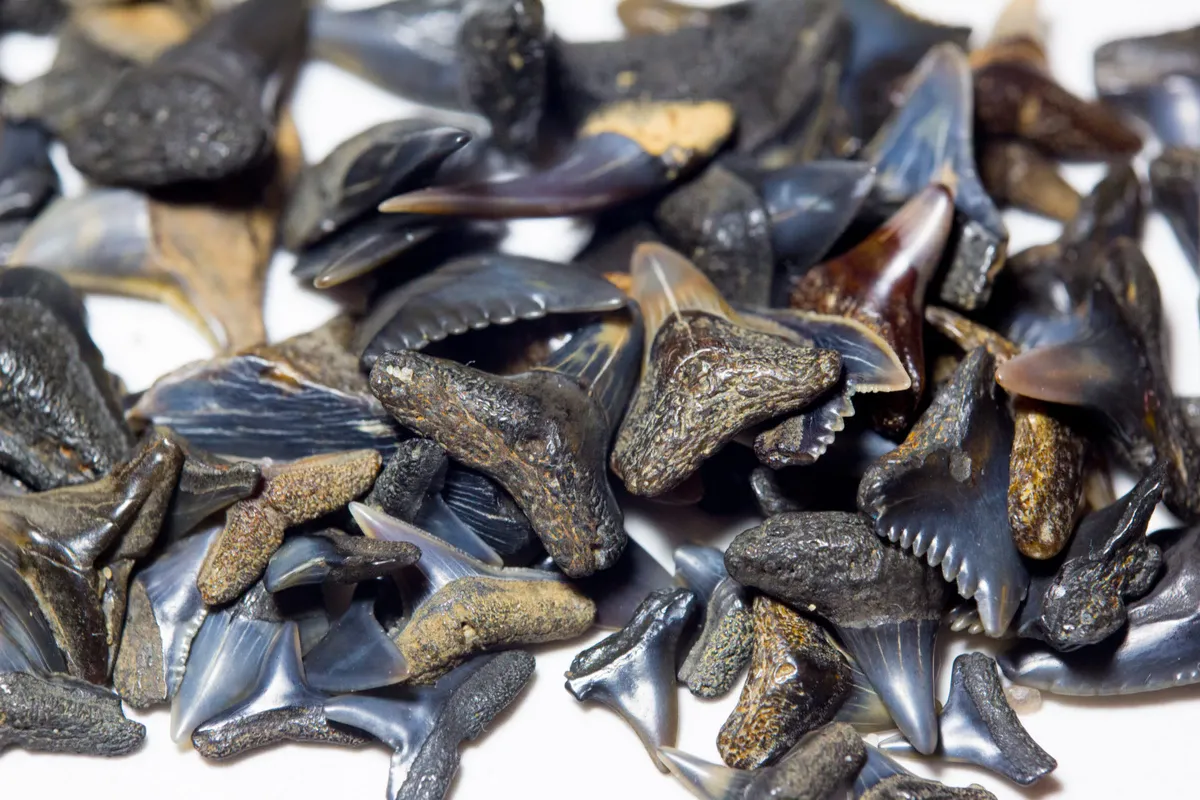
Image source: bestwesternsiestakey.com
2. No Bones About It!
It’s true! If you were hoping sharks were solid bone-crushing machines, you’re in for a surprise. Instead of bones, sharks have a skeleton made entirely of cartilage. Imagine them as the underwater versions of those wobbly, jelly-like structures we have in our noses and ears.
And while this makes them slightly less intimidating (because they’re somewhat squishy), it also means that discovering a full fossilized shark skeleton is as rare as spotting a unicorn at the beach. Though, given their cartilage frame, they do hold the title for the ocean’s most flexible swimmers.
3. Hammer Time!
Hammerhead sharks truly redefine ‘having eyes at the back of their head.’ With eyes positioned on the tips of their uniquely shaped heads, they have an almost 360-degree view. This fascinating adaptation means they can potentially keep an eye on two things at once. Watching two movies simultaneously? Observing both their prey and a potential mate? The possibilities are endless.
It’s no wonder they’re the envy of every multitasker in the ocean! Next time you feel overwhelmed, just think: “What would a hammerhead do?”

Image source: divephotoguide.com
4. The Overzealous Sunbather: Basking Shark!
If the ocean had a list of laid-back chillers, the basking shark would be right on top. As the second-largest shark species, right after the magnificent whale shark, it’s got a different approach to meals. Instead of chasing down prey, it prefers the more relaxed approach: swimming with its massive mouth wide open and letting plankton drift in like nature’s all-you-can-eat buffet.
Imagine just walking through a food festival with your mouth open, sampling everything in your path! While this might not be the most efficient method for kids at a candy store, for basking sharks, it’s just another day in paradise.
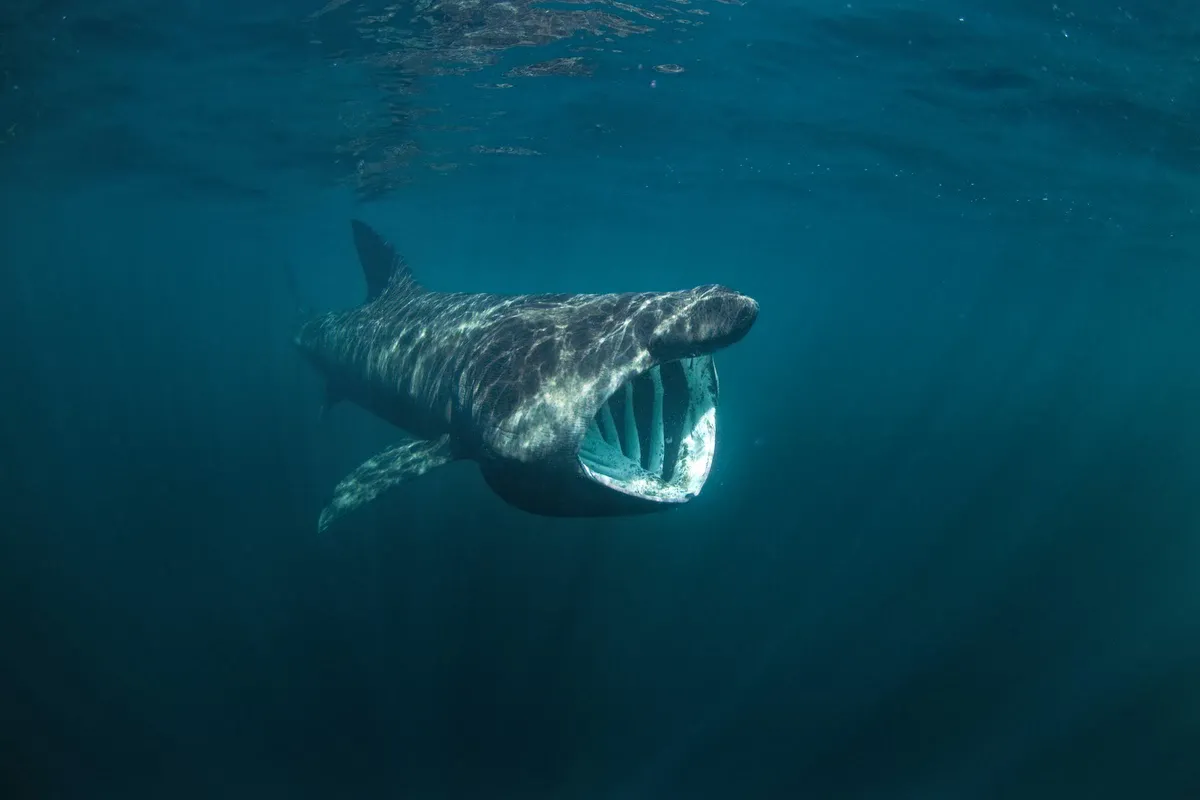
Image source: theconversation.com
5. Are Sharks Sleepyheads?
Ever wondered if sharks have snooze buttons? The answer is kind of a mix between “sort of” and “not really”. Sharks don’t nod off in cozy beds like we do. Instead, they’re the pioneers of the “on-the-move” nap. Many sharks need to keep swimming to breathe, so they’ve perfected the art of resting while still cruising around.
Imagine snoozing while taking your morning jog! Now, that’s efficiency at its best. This curious method is their version of hitting the bed, though it looks more like a floating meditation. It’s one of those interesting facts that makes you rethink your own nap game.
6. Slow and Steady… Lives Forever?
If there’s a Methuselah of the deep, it’s the Greenland shark. These slow-moving titans can live for up to an astounding 512 years. That’s right, four centuries! These are the grandmas and grandpas of the ocean depths, narrating tales from the times when pirates roamed the seas.
They’ve been around the block (or, in their case, the ocean) more than a few times. It’s like they’ve got an internal elixir of life, only, it’s set on ‘chill mode’. And while we’re on fun facts about sharks, imagine the birthday candles on their cake!
7. Leopard Sharks: Fashion Icons of the Ocean
Watch out, catwalk models, because the leopard sharks are here to steal the limelight! With their distinctive, swanky spotted patterns, they’re the trendsetters of the deep blue. It’s almost like they wake up every day, put on their polka-dot attire, and say, “The ocean is my runway!”
It’s no wonder they’re often featured in underwater photoshoots, giving top models a run for their money. They might not have fashion magazines under the sea, but if they did, leopard sharks would undoubtedly be on every cover.
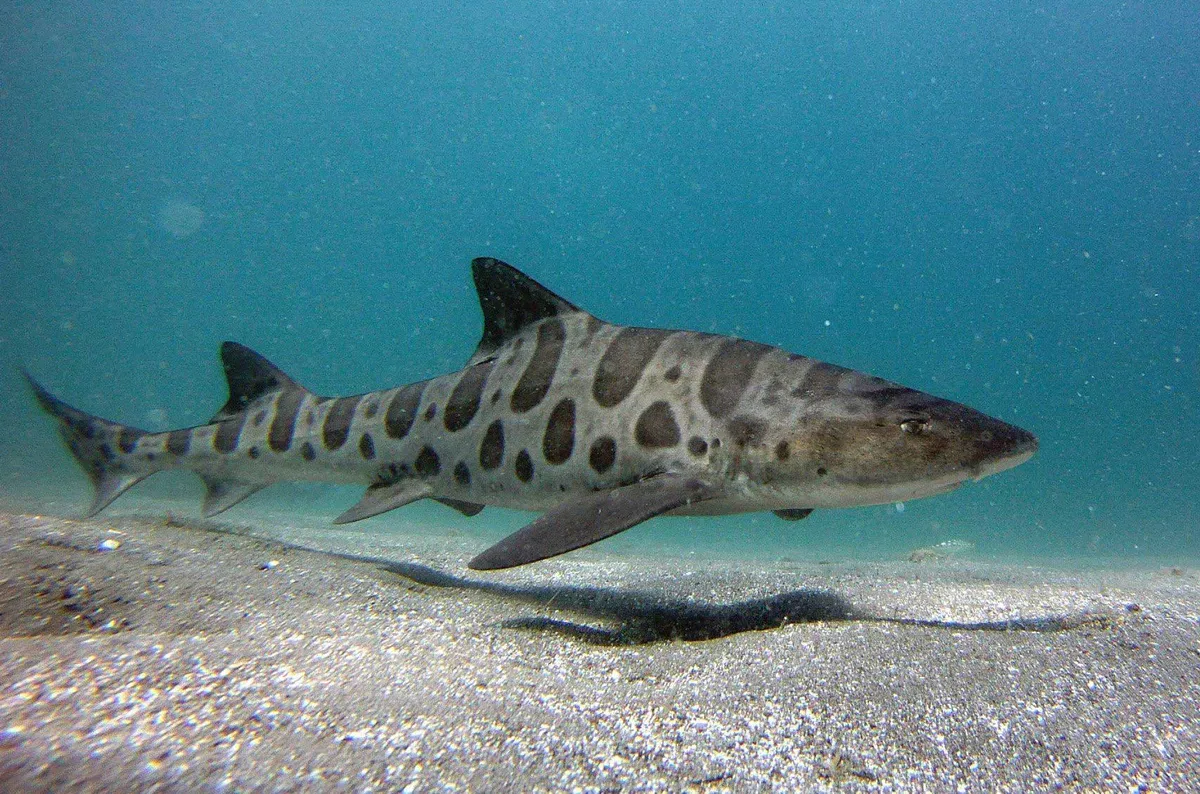
Image source: lajolla.com
8. Hang Tight with the Nurse Shark
Meet the ultimate chillers of the ocean – nurse sharks. These finned relaxers have truly mastered the art of ‘doing nothing.’ Preferring to laze around on the ocean floor, they’re rarely in a hurry, making them the embodiment of the word ‘chillax’. Think of them as the underwater equivalent of someone lounging in a hammock all day, every day.
If there were ever an oceanic version of the ‘Most Relaxed Shark’ award, these guys would win, fins down. We could all learn a thing or two from their ‘take it easy’ mantra.
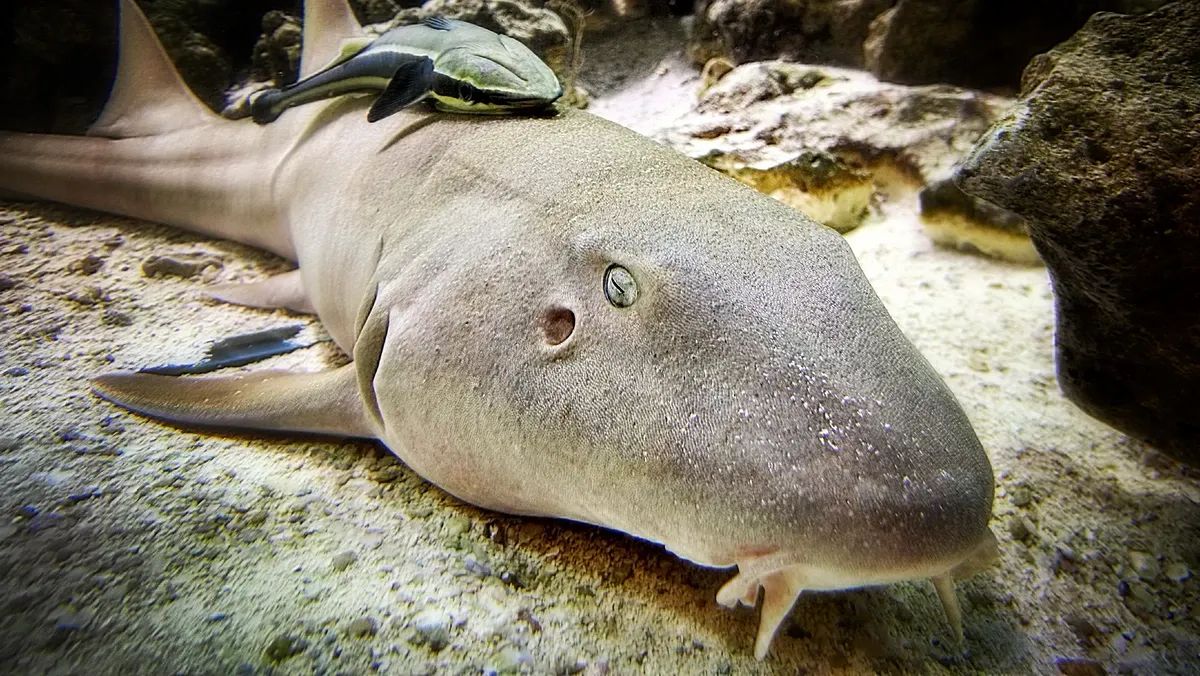
Image source: thoughtco.com
9. Real-life Glow Sticks
Move over, glow sticks at concerts, and make way for nature’s very own luminous marvels. Some sharks, like the Lanternshark, come with their very own glow-in-the-dark feature. This isn’t just some party trick; it’s bio-luminescence! They emit a greenish-blue light from special organs called photophores.
Imagine swimming in the ocean’s depths, only to witness a living, breathing underwater light show. No rave party could ever match up to that spectacle. It’s like the shark’s way of saying, “Who needs a flashlight when you’ve got natural bling?”
10. A Shark’s Sixth Sense
Forget maps, forget compasses. Sharks come equipped with a built-in radar system that’d make any tech geek green with envy. This “sixth sense” is called electroreception. Using special organs called ampullae of Lorenzini, sharks can pick up on electrical fields produced by other animals.
It’s like they’ve got a built-in metal detector, only it’s for fish and not buried treasure. So, next time you try hiding in the sea, remember, the sharks have got your number. It’s their very own GPS, with a menu that updates in real-time!
11. A Shark Named… Dog?
Here’s one for the books: the dogfish sharks. No, they don’t wag their tails or play fetch, but with a name like that, who could resist imagining them with a tiny tennis ball? These petite sharks might not come when called or sit on command, but they sure do know how to rule the waters in their own right.
Interestingly, the name “dogfish” was derived due to their pack-like hunting behavior, reminiscent of wild dogs. Who knew the aquatic world had its own set of furless ‘puppies’?
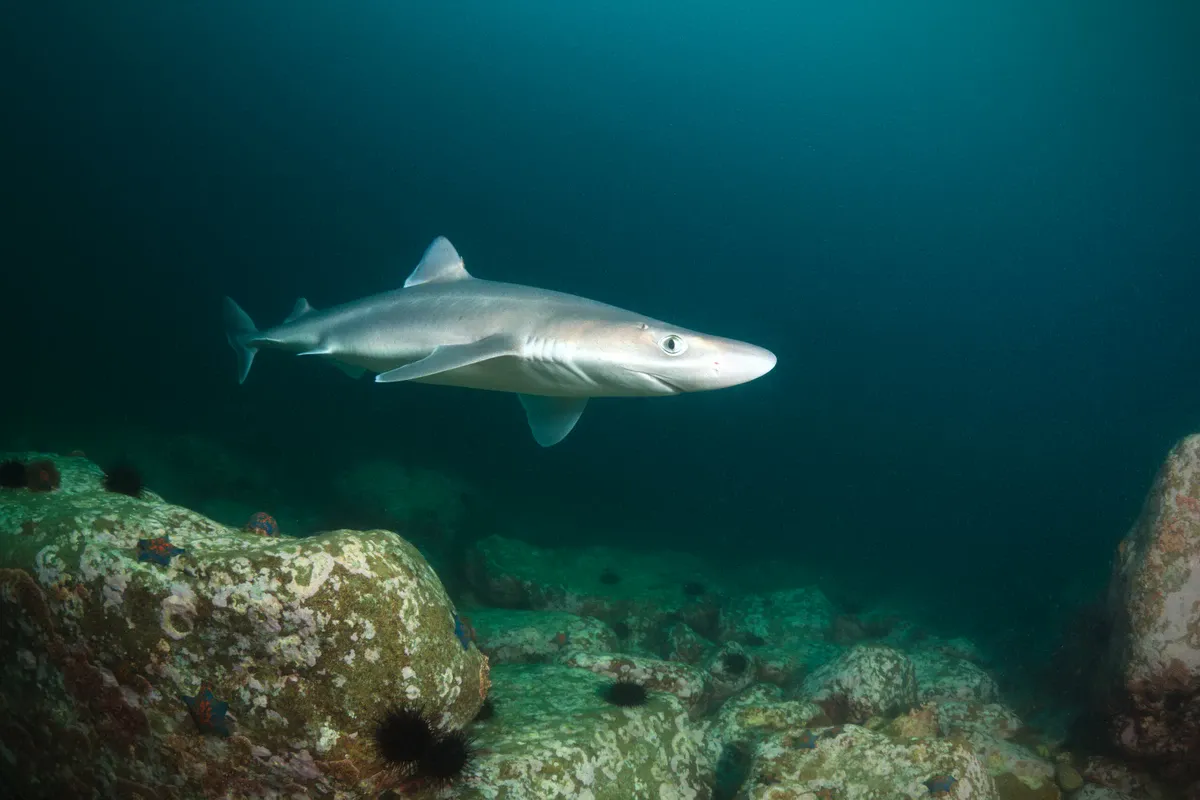
Image source: oceana.ca
12. Dancing With Shadows: The Epaulette Shark
Ever seen a shark that prefers to walk than swim? Meet the epaulette shark, the ocean’s elegant pedestrian! Found around the shallow waters of Australia, this remarkable creature uses its pectoral and pelvic fins to ‘walk’ along the ocean floor, especially during low tides when shallow coral reef pools are isolated from the sea. This peculiar behavior enables them to navigate tight spaces and hunt for crustaceans hiding in coral crevices.
While most sharks are symbols of streamlined grace in open water, the epaulette takes pride in its terrestrial flair, moving with an almost reptilian gait. It’s like watching a dance of shadows in the moonlit waters. So, the next time someone says they can “walk and chew gum at the same time,” ask them if they can do it underwater like an epaulette!
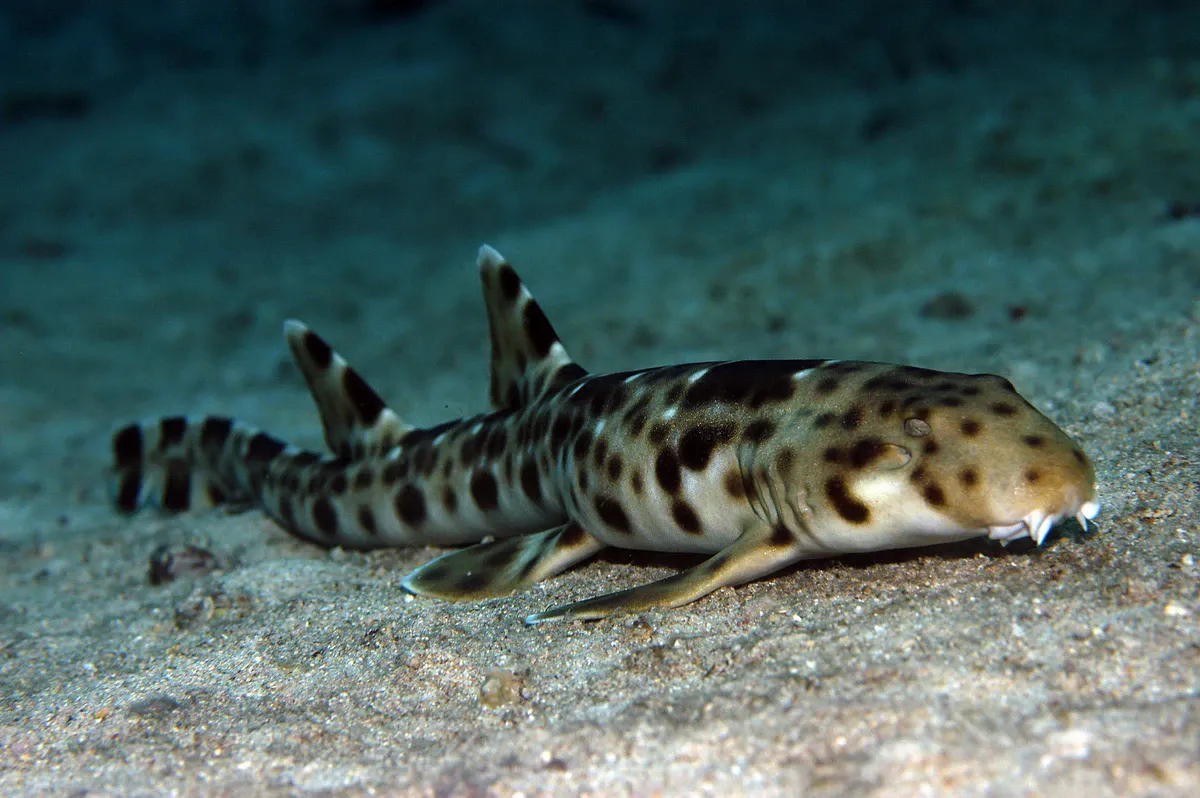
13. The Shark with Wings: Angel Shark
Ever dreamt of flying underwater? Look no further than the angel shark! This peculiar fish might make you double-take, thinking it’s a stingray. With a flat body reminiscent of a pancake and wing-like pectoral fins, they are more likely to be floating gracefully than darting aggressively.
They like to bury themselves under the sand, waiting for an unsuspecting meal to swim by. Talk about an ambush! And while their name implies a heavenly disposition, it’s probably best not to mistake them for cuddly cherubs; they are, after all, still sharks!
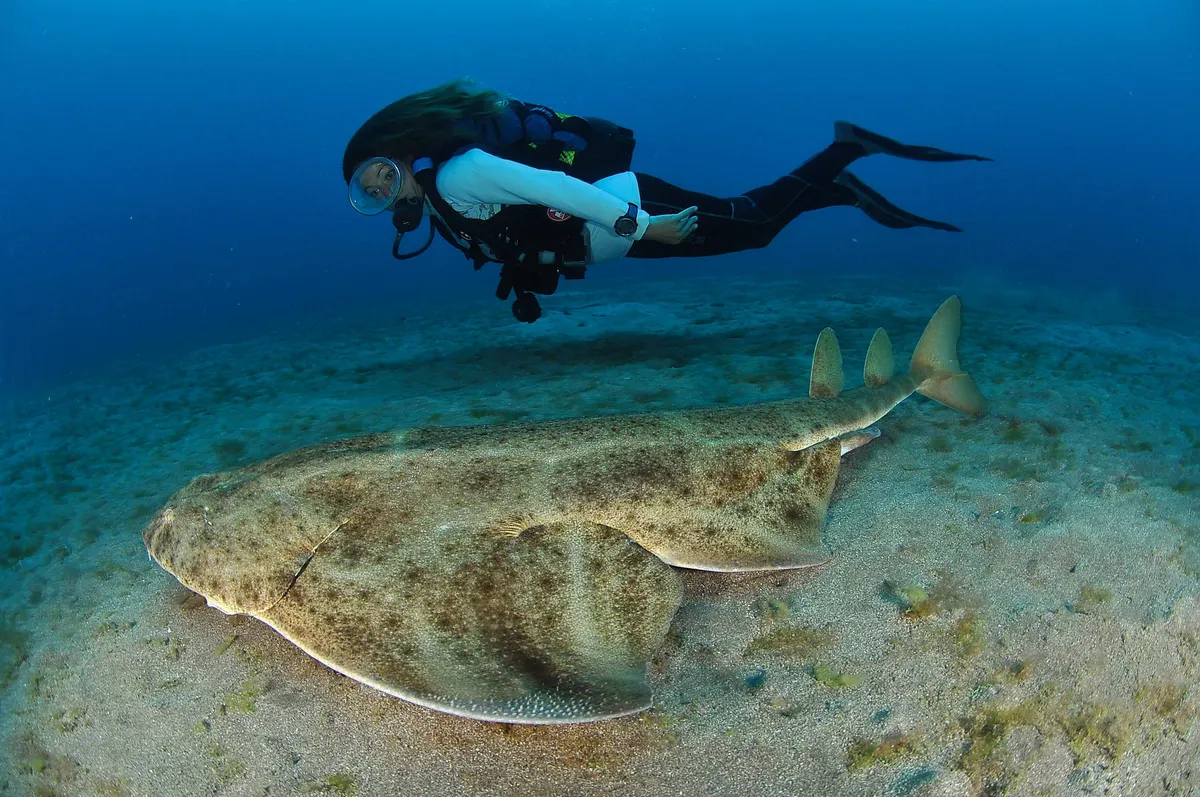
Image source: saveourseasmagazine.com
14. Veggie Lovers: Bonnethead Sharks
Move over, vegetarian friends; there’s a new plant-lover in town! Among the vast array of carnivorous sharks, the bonnethead shark stands out with its balanced diet. Not only does it snack on crustaceans and small fish, but it also relishes a good seagrass salad.
In fact, studies have shown that up to 60% of their intake can be seagrass. Bonnetheads: Breaking shark stereotypes, one blade of grass at a time. Next time you see one, maybe offer it some salad dressing?
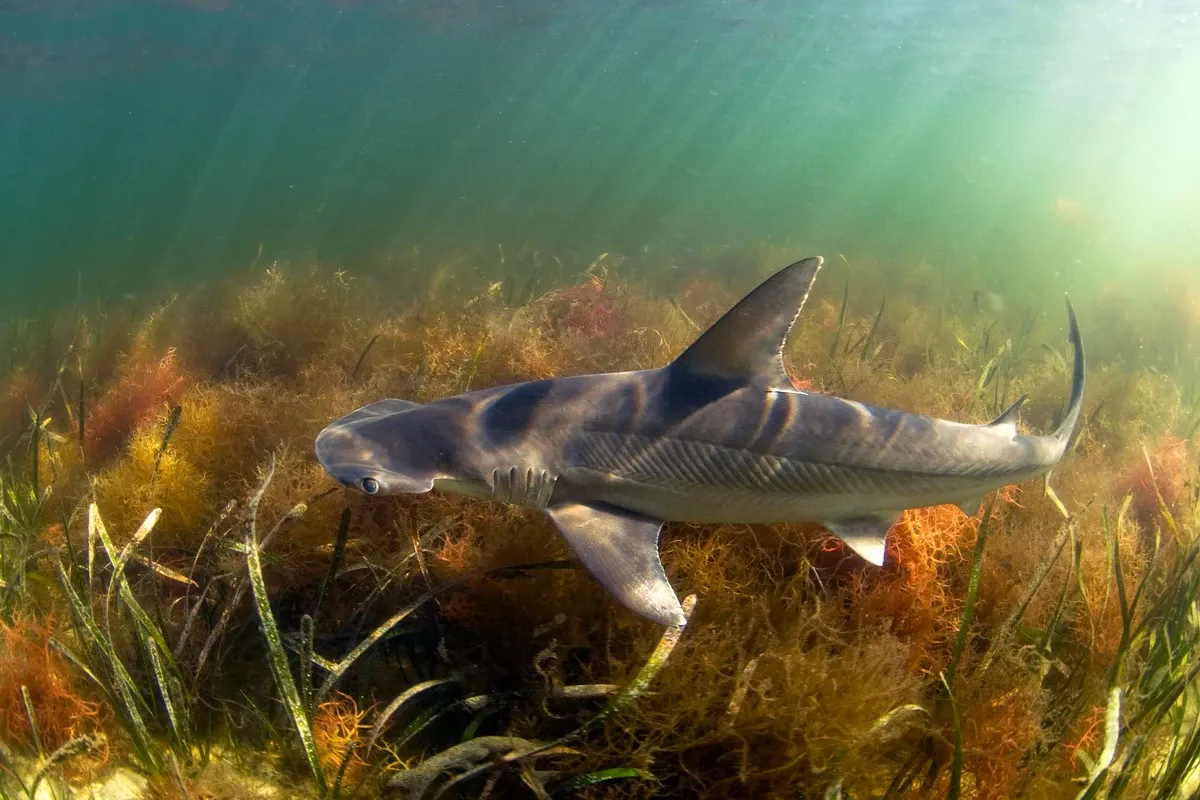
Image source: nytimes.com
15. Tiniest Sharks: The Dwarf Lantern
Whoever said bigger is better clearly hasn’t met the dwarf lantern shark. Measuring just about the size of a human hand, this little fella is a reminder that dynamite comes in small packages. Its bioluminescent belly lights up, making it the ultimate night light for deep sea divers.
So, if you ever imagined keeping a shark in your fish tank, this could be your best bet! Just remember, it’s still a shark – tiny, glowing, but fierce.
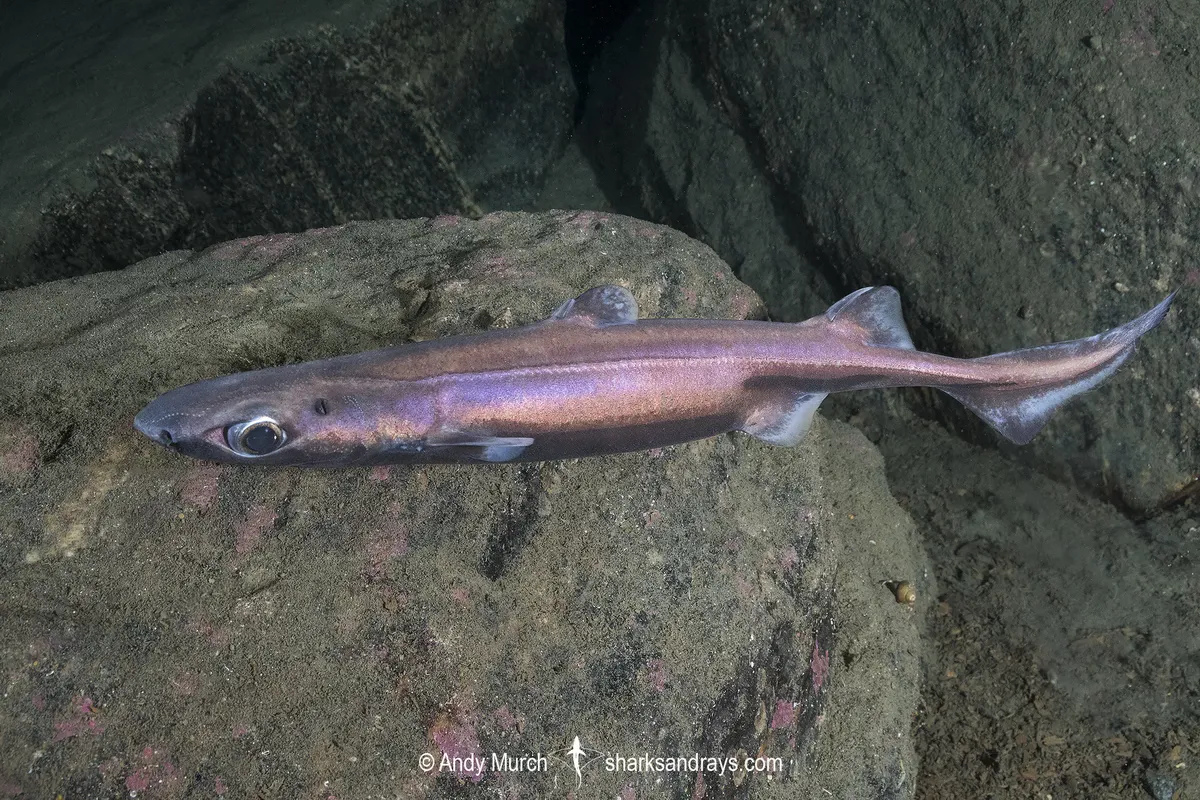
Image source: sharksandrays.com
16. Going Retro: The Frilled Shark
Talk about vintage fashion! The frilled shark is one of the oldest (still living) shark species. With its eel-like body and ruffled gills, it’s a blast from the past, living in our present. It’s like they took a look at evolution and said, “No thanks, I’m good.”
Residing deep in the ocean, they’ve kept their primordial charm intact for over 80 million years. They don’t chase after trends – they set them (well, millennia ago)!
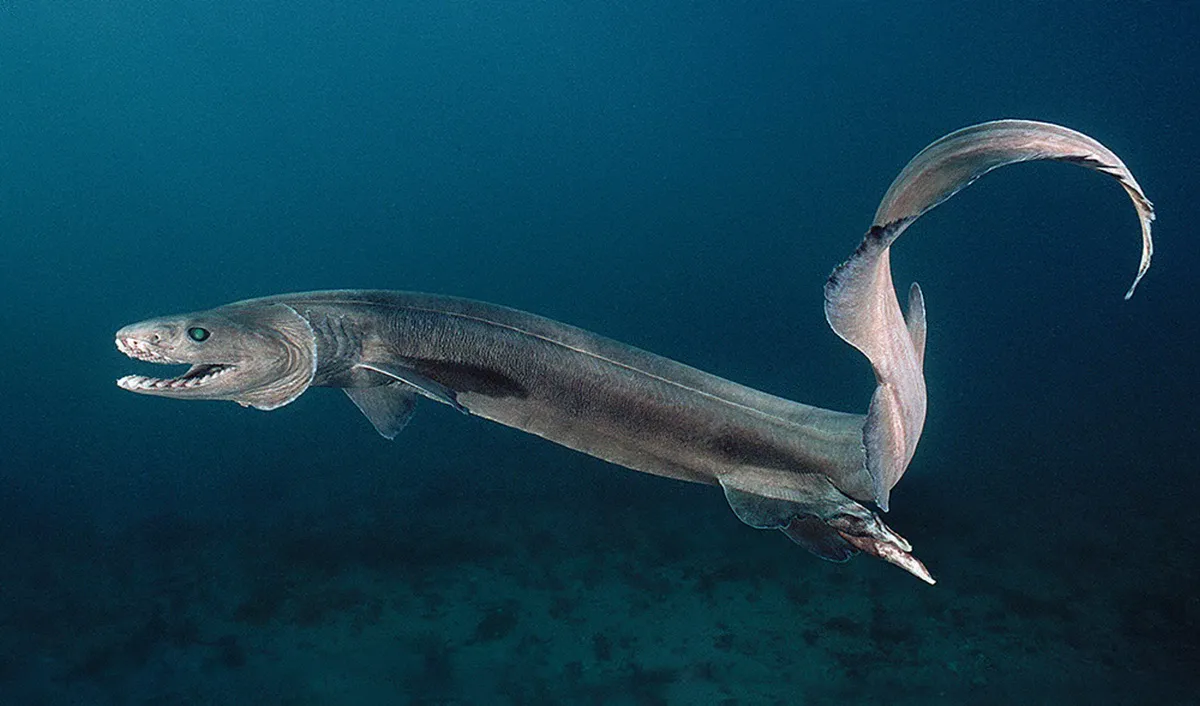
Image source: grannyflatapprovals.com.au
17. The Real Zebra of the Ocean: Zebra Shark
Meet the shapeshifter of the sea, the zebra shark! When these sharks are just wee pups, they sport zesty zebra-like stripes. But, as they grow, they think, “Why stick to one pattern?” and switch it up to a spotty ensemble.
It’s like nature’s version of going from polka dots in your teens to leopard prints in your twenties. If the animal kingdom had a fashion week, the zebra shark would be the talk of the runway, flaunting its wardrobe transformation like a true diva.

18. All Bark, No Bite: The Whale Shark
Talk about being misunderstood! The whale shark, with its gargantuan size, can seem like the ultimate predator. But in reality, it’s the gentle giant of the seas. Despite having a mouth that can be up to 4.9 ft wide, its diet is more like “tiny delicacies only.”
Zooplankton, tiny fish, and small squid are its marshmallows. Imagine a colossal creature just floating around, filtering tiny meals. It’s like Goliath having a tea party!

Image source: wp.com
19. Frequent Flyer Miles of the Sea: Mako Shark
You know how we have sports cars on land? The ocean’s answer to that is the Mako shark. Streamlined, sleek, and seriously speedy, this shark is the Usain Bolt of the ocean waves. Reaching speeds of up to 60 mph, it’s faster than most cars in a city!
If marine creatures had Olympics, the Mako would be scooping gold medals in the sprint category. So, if you see a flash of grey and blue while you’re snorkeling, it might just be a Mako saying, “Beep beep, coming through!”
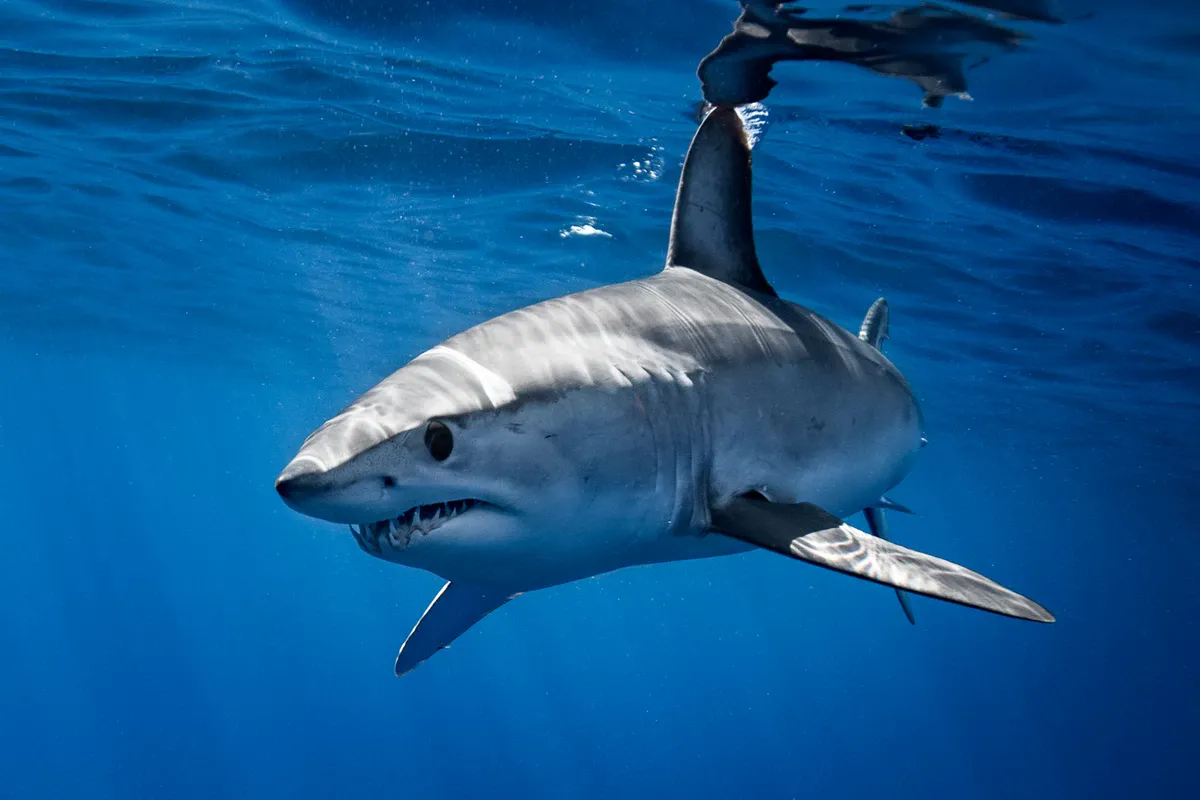
Image source: my-pet.store
20. It’s All in the Tail: Thresher Shark
Meet the ocean’s very own Indiana Jones – the thresher shark! But instead of a whip, this swashbuckler uses its extended tail, which can measure half its body length. A swing of that tail, and its prey doesn’t know what hit it. It’s the underwater version of a surprise slapstick moment.
If the thresher had a catchphrase, it’d probably be, “Talk to the tail!” With such a unique hunting technique, it’s no wonder these sharks stand out in the big blue.
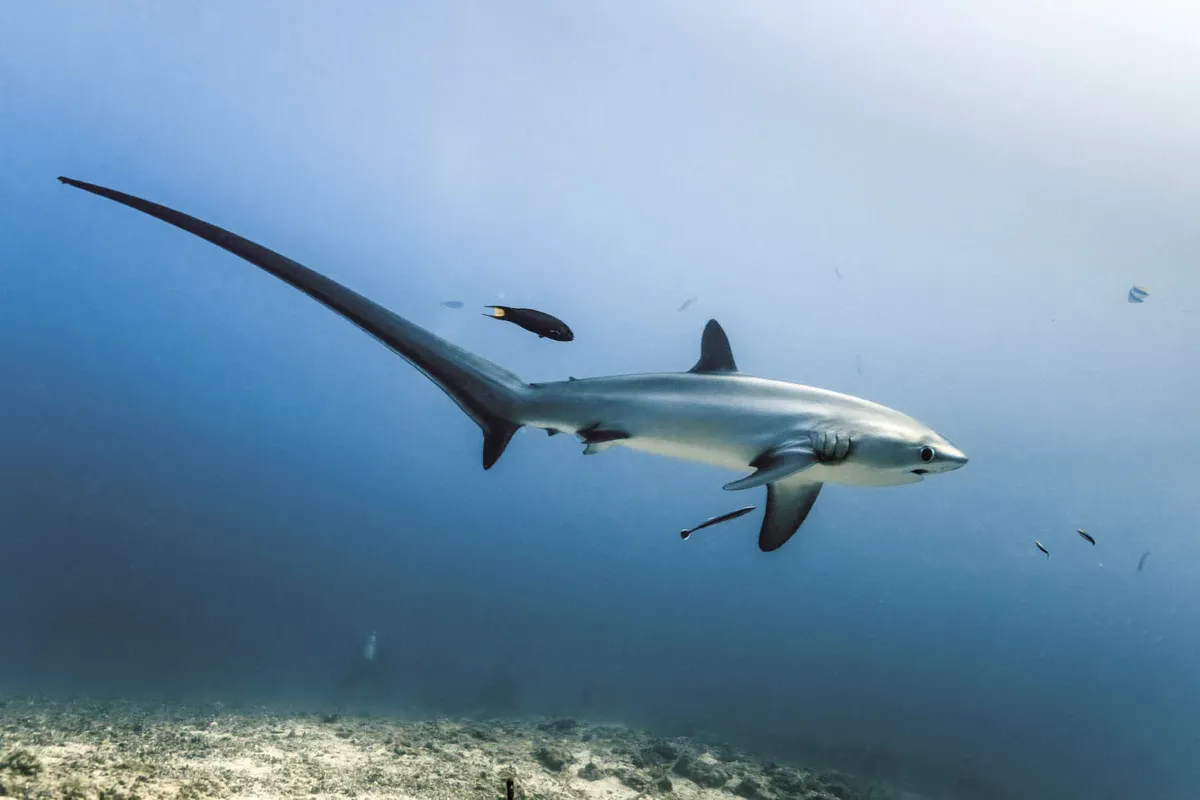
Image source: wallpapercave.com
21. Camouflage Kings: Wobbegong Sharks
If the ocean had a “hide and seek” championship, the Wobbegong sharks would win, fins down! These masters of disguise have mastered the art of camouflage to such a degree that even the ocean floor is left saying, “Wait, where did you go?!” Perfectly blending in with their surroundings, Wobbegong sharks are like the chameleons of the ocean, but with a bit more bite.
This camouflage isn’t just for fun, though. It’s their secret weapon in ambush hunting. Their prey won’t even know what hit ’em until it’s too late. So, if you’re snorkeling and see a seemingly innocent patch of sand, look closer. It might just wink back!
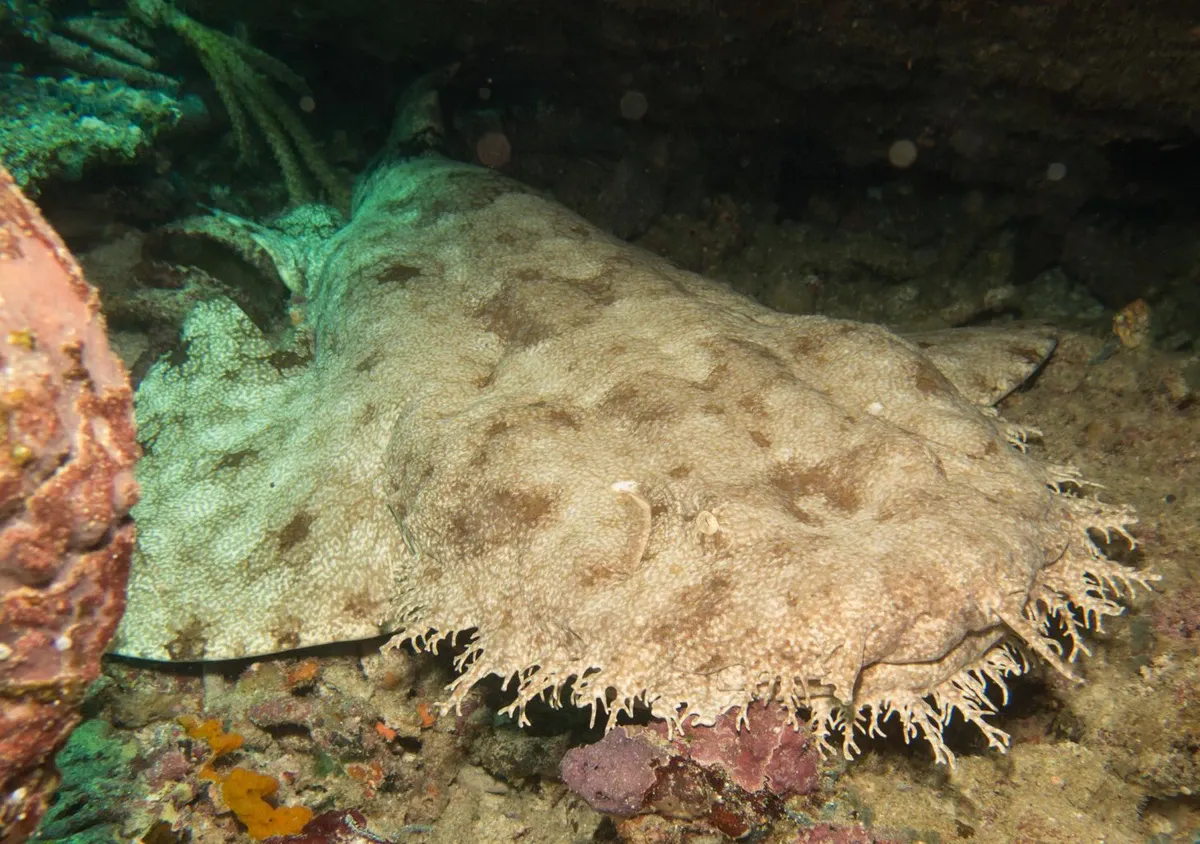
Image source: twinislanddive.com
22. Not as Fierce as They Sound: Tiger Sharks
Ever heard of the saying, “Don’t judge a book by its cover”? The tiger shark should be the poster child for it. With a name that invokes terror, these sharks are surprisingly non-discriminating when it comes to their diet. License plates, rubber tires, nails, shoes – you name it, they’ve probably tasted it. It’s like they’re on a perpetual episode of “Shark Fear Factor.”
Still, their odd diet choices shouldn’t overshadow the fact that they’re magnificent creatures, vital for the marine ecosystem. But, if they ever invite you for dinner, maybe politely decline.

Image source: maralliance.org
23. Lightweight Champs: Bull Sharks
Meet the ocean’s most versatile swimmers, the bull sharks! While some of us can’t decide between a salted caramel or plain caramel latte, bull sharks are out there effortlessly switching between freshwater and saltwater habitats. They have been found cruising the deep ocean, river estuaries, and even some lakes!
Bull sharks truly epitomize adaptability. It’s like they looked at the map, pointed everywhere, and said, “I want to swim there, there, and oh, there too!” Adventurous, adaptable, and always on the move, they’re the real globetrotters of the marine world.
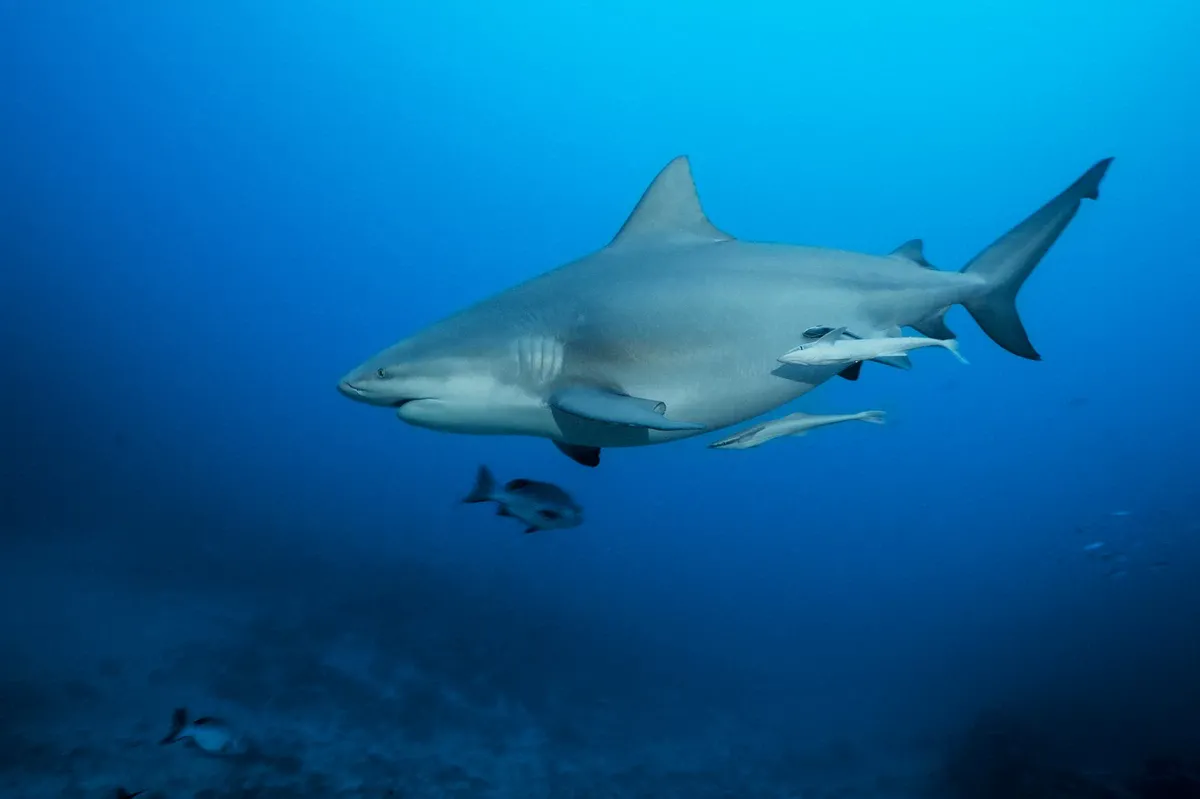
Image source: National Geographic
24. The Leopard’s Cousin: The Leopard Catshark
You might’ve heard of night owls, but have you heard of night sharks? Enter the Leopard Catshark, the ocean’s after-hours party animal. Much smaller than their distant relatives, the leopard sharks, these nocturnal beauties are all about the nightlife.
Dressed in a fashionable coat of stunning spots, they prowl the ocean floor once the sun goes down. Think of them as the mysterious, cloak-clad figures in the corner of the marine nightclub, always observing, always waiting. They may not be the biggest or the fiercest, but in terms of style and mystery, they take the cake.
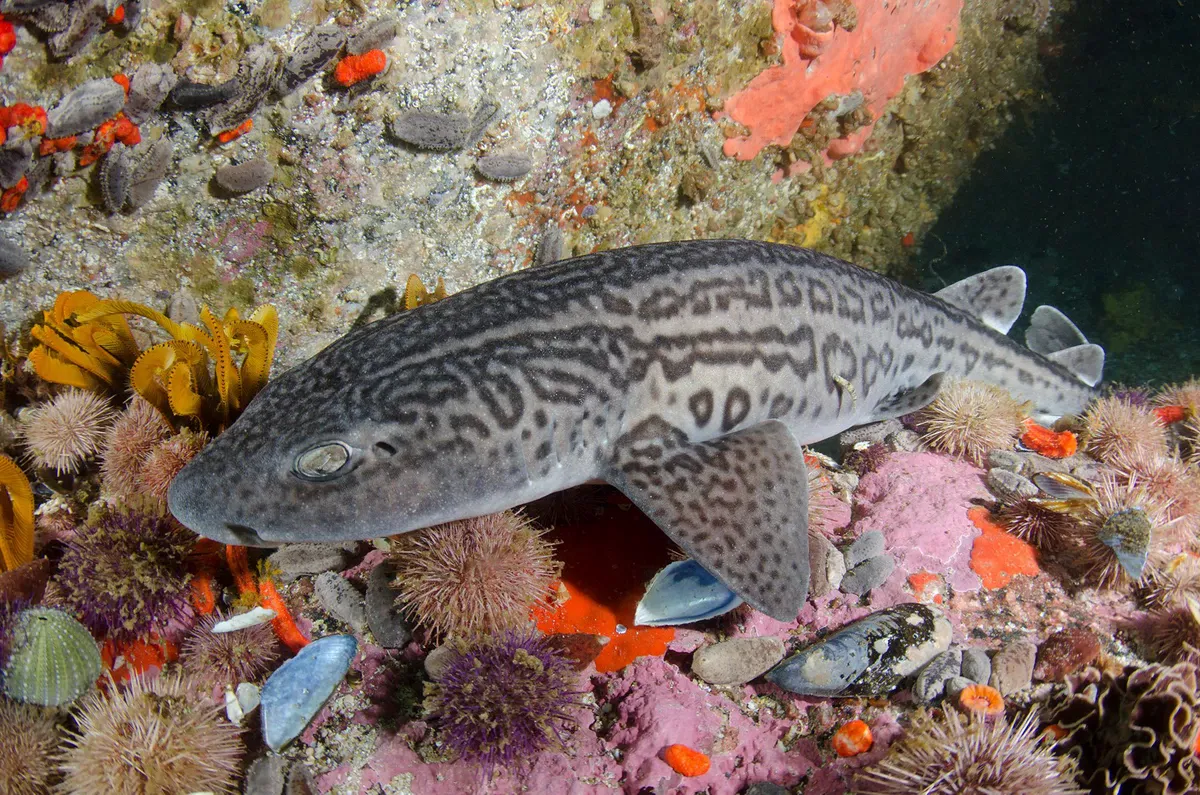
Image source: bigfishexpeditions.com
25. Nature’s Underwater Flashlight: The Cookiecutter Shark
You’d think a name like “cookiecutter” would imply a cute, harmless creature, right? Think again! This fascinating little shark gets its quirky name from the unique, cookie-shaped wounds it leaves on larger animals. But, there’s another fun fact about them that’s less commonly known: they glow!
That’s right, the cookiecutter shark is bioluminescent, giving it a spooky glow in the pitch-black waters of the deep. This light show isn’t just for kicks; it plays an essential role in attracting prey. The shark’s underside lights up, drawing curious creatures closer, thinking it might be a smaller, harmless fish. But here’s the sneaky part: a dark patch on its throat remains unlit, resembling a small fish’s silhouette. Larger predators are lured in thinking they’re about to get a snack, only to end up on the cookiecutter’s menu instead.
In the eternal words of Admiral Ackbar from Star Wars, “It’s a trap!” And a glowingly brilliant one at that!
26. The Daredevil Dining of the Great White Shark
When it comes to hunting, the great white shark takes dining to an aerial level! Known for their breaching behavior, these sharks have a knack for launching themselves out of the water, especially when chasing a tasty seal. Imagine the sheer power required to propel a several-thousand-pound creature out of the ocean! It’s like watching an aquatic rocket launch with teeth.
The force, speed, and strategy they employ are nothing short of astonishing. This behavior showcases not just their strength but also their calculated precision in catching prey. Dining isn’t just a necessity for these guys; it’s a high-flying spectacle! So, while most fish keep it low-key, the great white ensures its meals come with a splash and a show.
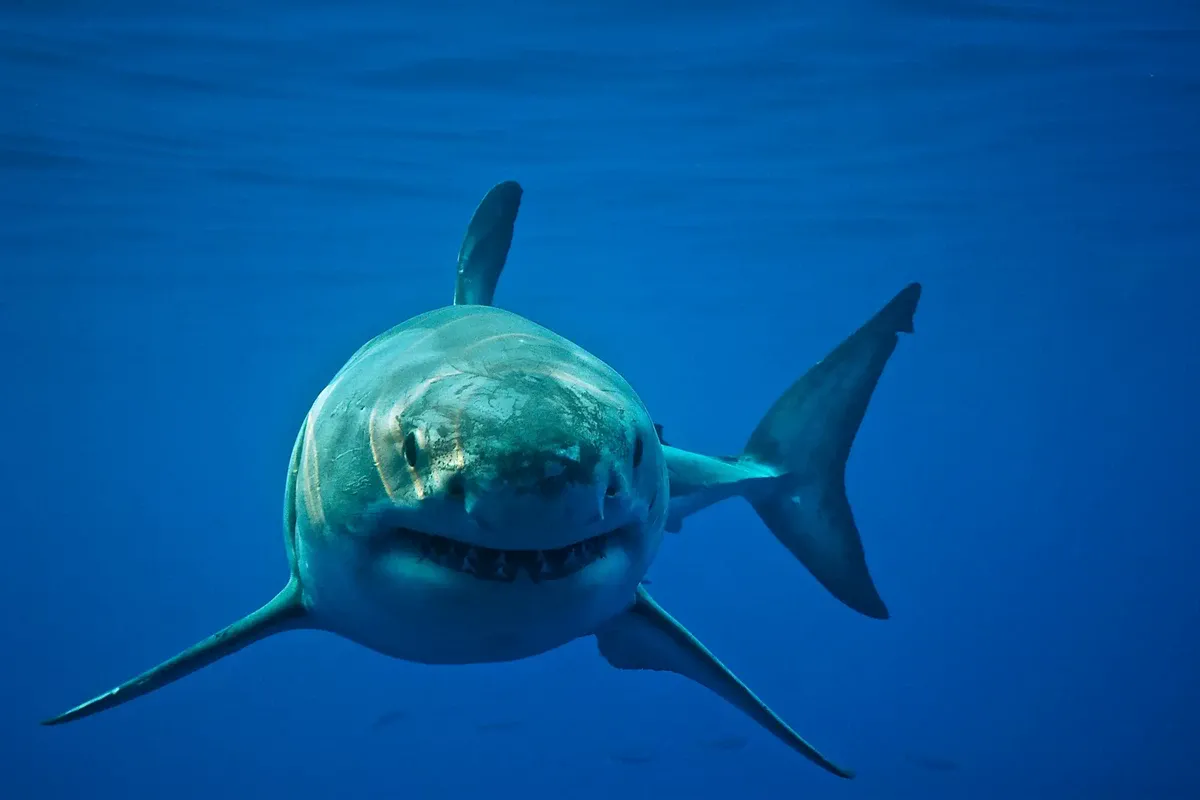
Image source: nypost.com
27. The Odd One Out: Greenland Shark
Puberty blues? Imagine waiting 150 years to hit maturity! The Greenland shark, often called the Methuselah of the oceans, takes “growing up is hard” to a whole new level. Most of us get impatient waiting for a 2-minute microwave meal, and here’s this shark, patiently waiting over a century to mature.
Perhaps it’s nature’s way of telling them to savor their childhood. These sharks witness eras, silently swimming through the pages of history, outliving civilizations and trends. They’re not just swimming through oceans; they’re swimming through time. And if they had yearbooks? Let’s just say they’d have a lot of class photos.
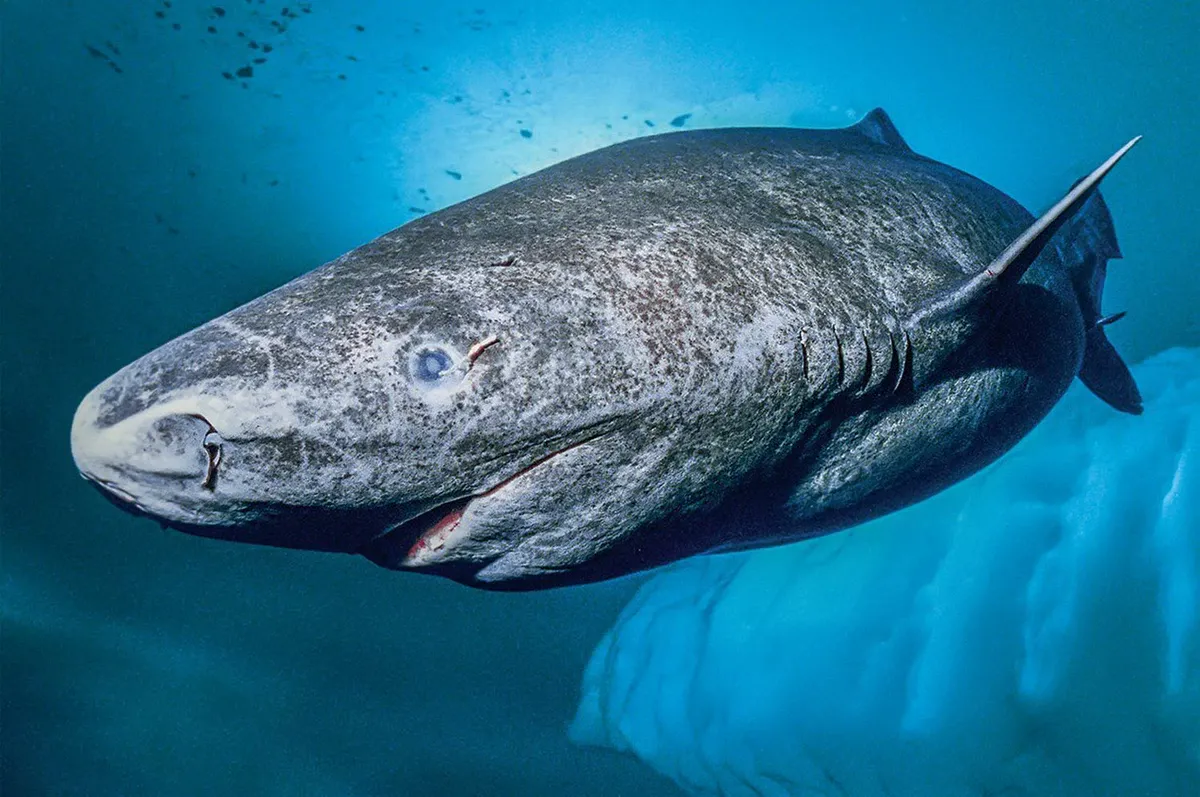
Image source: sciencenordic.com
28. The Attention Seeker: Swell Shark
Ever wanted to make a statement without saying a word? The swell shark has it down to a science. When feeling threatened, this drama king takes a big gulp of water, puffing itself up to nearly double its size! It’s like the ocean’s version of inhaling a bunch of helium balloons but with more gravitas.
If only we humans had this talent when navigating a crowded subway or wanting that extra space in a cinema. “Excuse me, I need to swell up now.” The next time someone tries to steal your limelight, channel your inner swell shark and…maybe just take a deep breath.

Image source: sharkwater.com
29. The Nursery Lovers: Lemon Sharks
Ever thought sharks might have a soft side? Let’s introduce you to the lemon sharks! These finned fellows are known to return to their birthplace, which are typically shallow mangroves, when it’s time to give birth. It’s like a nostalgic homecoming or revisiting your childhood treehouse, but with a splash!
These “nurseries” offer young lemon sharks protection from larger predators and a smorgasbord of food to snack on. It’s an all-inclusive baby-shark resort! This maternal instinct shows that there’s more to sharks than just being apex predators; they’re caring mothers ensuring the best for their young. So next time you reminisce about your childhood playground, remember, the lemon sharks are doing the same, but with a bit more salt and waves involved.
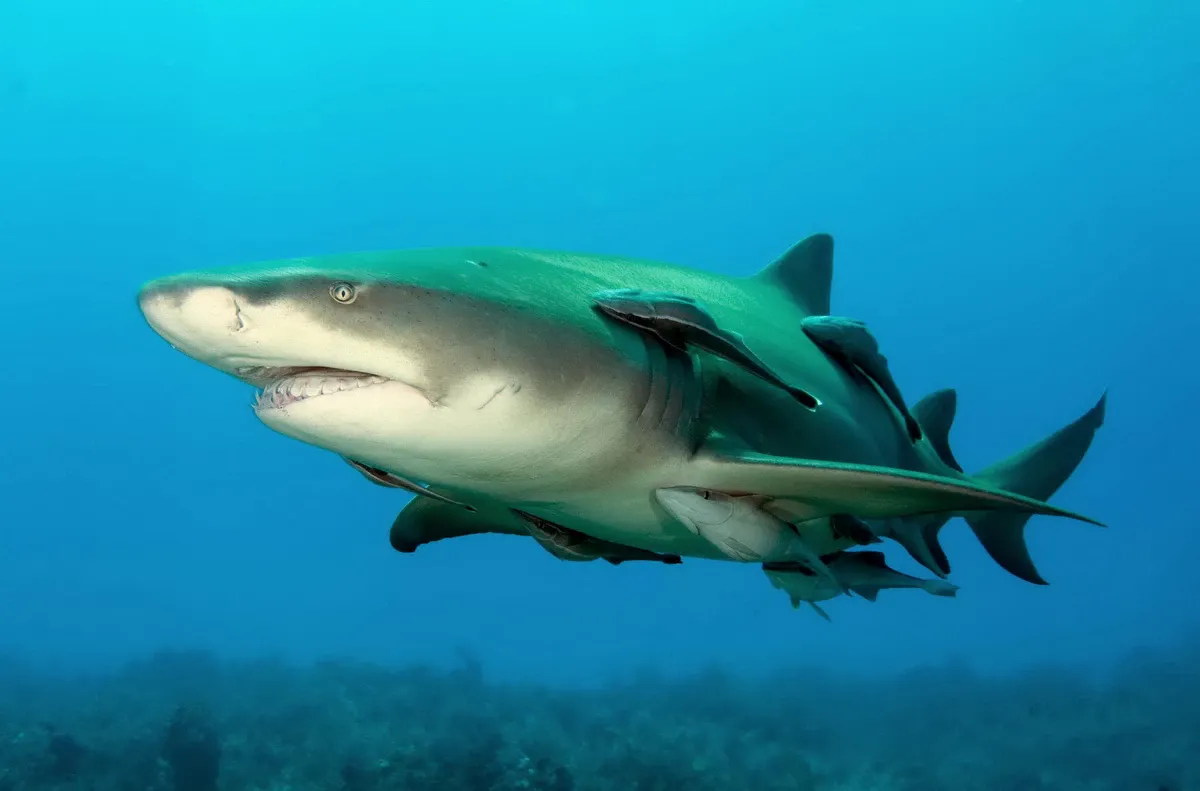
Image source: wikipedia.org
30. Mr. Invisible: Gray Reef Shark
Hide and seek champions, anyone? The gray reef shark might just snag the title. These masters of disguise seamlessly blend into their surroundings, making them almost invisible to the untrained eye. It’s like they attended Hogwarts and borrowed Harry’s invisibility cloak!
Divers often get a surprise when they suddenly spot one, realizing that the shark was chilling nearby all along. It’s like having a ninja buddy who’s great at stealth mode. So, if you’re planning a game of underwater hide and seek, you might want to check twice before declaring the coast clear.

Image source: casenewsdev.fiu.edu
FAQ
What are 20 interesting facts about sharks?
- Sharks have been around for over 400 million years, predating dinosaurs.
- They have a sixth sense, known as electroreception, which helps them detect the electrical fields of their prey.
- There are over 400 known species of sharks.
- The dwarf lantern shark can fit in the palm of a human hand.
- Whale sharks, the largest species, are filter-feeders and pose no threat to humans.
- Sharks have multiple rows of replaceable teeth.
- Some species of sharks can glow in the dark due to bio-luminescence.
- The Greenland shark is one of the longest-living vertebrates, living up to 400 years.
- Bull sharks can thrive in both saltwater and freshwater.
- The fastest shark is the Mako shark, reaching speeds up to 60 mph.
- The swell shark can swell up like a balloon when threatened.
- Nurse sharks often rest on the ocean floor.
- Shark skin feels similar to sandpaper due to tiny tooth-like structures called denticles.
- Sharks can go into a trance-like state called tonic immobility when flipped upside down.
- The tiger shark is known as the ‘wastebasket of the sea’ due to its varied diet, which can even include inanimate objects.
- Lemon sharks use the ampullae of Lorenzini, a network of pores, to detect electrical fields from prey, even if it’s hidden under sand or in murky waters.
- Angel sharks resemble rays with their flat bodies.
- Some species, like the hammerhead, have 360-degree vision.
- Baby sharks are called pups.
- Some female sharks can reproduce without mating through a process called parthenogenesis.
What is the rarest shark fact?
One of the rarest facts is about the pocket shark. Only two specimens have ever been found: one in the Gulf of Mexico in 2010 and another off the coast of Chile in 1979. It’s named for the pocket-like orifices found behind its pectoral fins.
What is the #1 deadliest shark?
The great white shark is often considered the deadliest, responsible for the largest number of unprovoked attacks on humans.
What is the scariest shark still alive?
While “scariest” is subjective, many would vote for the great white shark due to its size, power, and portrayal in media, especially movies like “Jaws.”
What killed the megalodon?
The exact reason is still debated, but it’s believed a combination of factors led to the extinction of Megalodon around 2.6 million years ago. These include climate change, reduction in their primary food sources due to competition from other predators, and possibly even encounters with early ancestors of the great white shark.
Has a shark ever saved a human?
There are anecdotal stories and claims of dolphins saving humans from sharks, but documented cases of a shark explicitly “saving” a human are rare and not scientifically verified.
What is the nicest shark?
The whale shark is often dubbed the “gentlest giant” due to its calm nature and filter-feeding habits, making it harmless to humans.
What is the most playful shark?
White-tip reef sharks have been observed exhibiting playful behaviors, especially around divers, making them one of the more interactive shark species.
What sharks cuddle?
Sharks don’t “cuddle” in the human sense of the word. However, nurse sharks are often seen resting on the ocean floor and are known to be more docile, allowing divers to approach them closely. This is not the same as cuddling, but their approachable nature might give that impression.
Do sharks ever sleep?
Sharks don’t sleep like humans. They have periods of reduced activity and rest, but they remain alert. Some species need to keep moving to ensure a constant flow of water through their gills for oxygen. Others, like the nurse shark, can remain stationary and breathe by pumping water through their mouths and out their gills.


